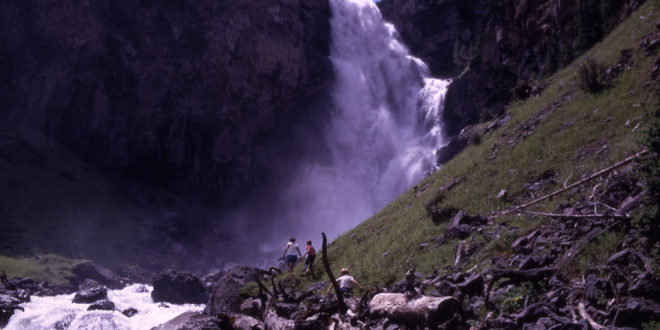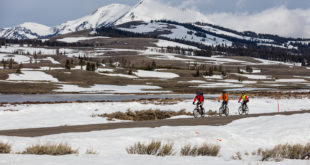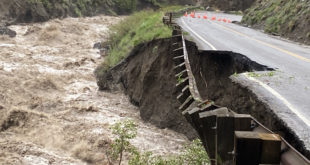It’s high season in Yellowstone, but it’s still possible to get out and enjoy the Park without having to share it with a gazillion other tourists and their shrieking kids. How? Go for a Yellowstone day hike.
Seriously, even 100 yards off the road, there’s nobody. And there are also very few people if you get serious about a seriously early departure. With first light around 5 a.m., there’s a lot you can do before the crowds are up and moving around.
And fortunately, even if you get a late-morning start like I did, the hottest part of the day isn’t very hot.
A pal and I decided to head down the Osprey Falls trail. The easiest place to start is at the Bunsen Peak trailhead at the northern end of Swan Lake Flats, which is about five miles south of Mammoth Hot Springs. The Osprey Falls trail is a good one for being at slightly lower elevation than a lot of the rest of the park, so it tends to warm up and dry out faster. And the trail follows an old dirt road, so the walking is relatively easy. And there’s minimal elevation change — at least until you get to the switchbacks that take you down to the falls.
The old road continues down and around Bunsen Peak, emerging in an employee housing area about two miles from the main Mammoth Hot Springs compound. If you like to walk uphill without much of a break, you can also start your hike here. The road switchbacks relatively gently, which makes it a popular cross-country ski route in winter.
The weather was as glorious as it gets in Yellowstone — a warm sun tempered with a cool breeze. The sky was bluebird blue and the surrounding terrain still nearly Ireland-green, thanks to the cool, wet season to date.
The wildflowers were dazzling. I’ve never seen so much — and so intensely purple — larkspur. The lupine was just starting up, the phlox were still brilliant, and a ton of strawberry plants were flowering. The tiny berries are usually hard to come by between birds and bears, but their flavor beats the grocery stores species by a factor of at least 100.
The trail is mostly out in the open with scenic vistas all around, but passes through a few small stands of lodgepole pine. Even today, 30 years later, there’s still evidence of charred limbs and blackened snags from the North Fork Fire, which burned through this area in 1988. There are plenty of new trees, and the surrounding open country is still mostly sage and other native plants.
Osprey Falls on the Gardner River drops 150 feet into the Sheepeater Canyon. Peering over the rim, I counted 5 different layers of columnar basalt, formed from lava flows in Yellowstone’s more active volcanic distant past. From 700 feet above the river, the water was green and fast-moving and resembled the Yellowstone River where it flows through its own canyons. And a cool breeze with a hint of spray in it reached me even that high above the water.
The trail drops vertiginously 700 feet in 1.4 miles with a steady stream of switchbacks. The top of the canyon is a good place to stop and go no further if you don’t like switchbacks and steep drop-offs or if you’ve just arrived from sea level and might still be feeling the effects of thinner air at Yellowstone’s 6,000 feet — and in most places, higher — elevation.
See Yellowstone’s trail description here.
Photo of Osprey Falls by William W. Dunmire (1968), courtesy National Park Service.
 Yellowstone Insider Your Complete Guide to America's First National Park
Yellowstone Insider Your Complete Guide to America's First National Park





